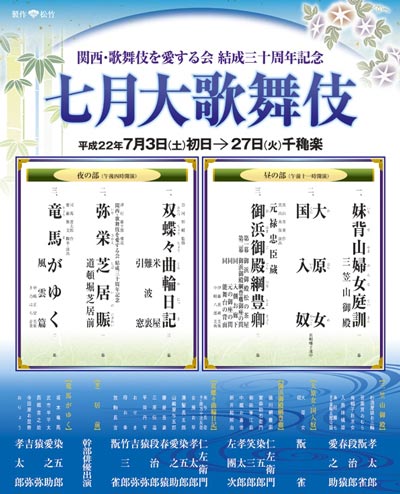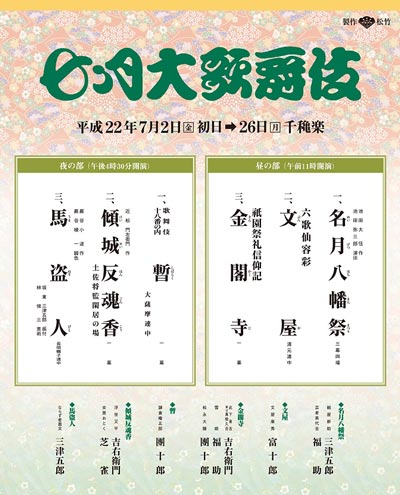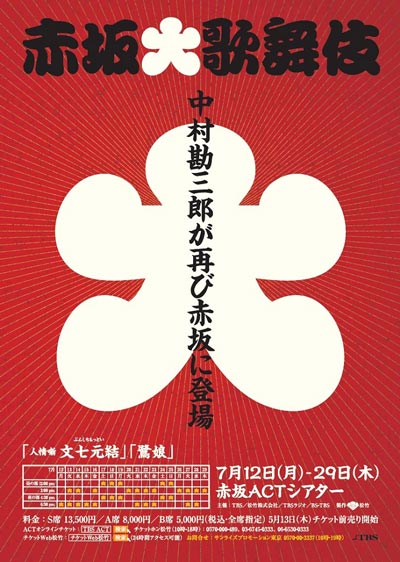| JULY 2010 |
|
4 shows in T˘ky˘ (Shinbashi Enbuj˘, National Theatre, Akasaka Act Theater), 2 in ďsaka (Sh˘chikuza), 1 in Matsumoto (Matsumoto Performing Arts Centre) and 3 tours (Eastern Provinces, Central Provinces, Zenshinza)!
|
| Sh˘chikuza (ďsaka) |
| Dates | 3 ~ 27 July 2010 (Shichigatsu ďkabuki) July Grand Kabuki |
| MatinÚe |
Imoseyama Onna Teikin Oharame Kuniiri Yakko |
| Evening |
Iya Sakae Shibai no Nigiwai (D˘tonbori Shibai-mae) Ry˘ma ga Yuku |
| Casting |
Kataoka Nizaemon, Nakamura Kanjaku, Kataoka Ainosuke, Kataoka Takatar˘, Ichikawa Sadanji, Kamimura Kichiya, Band˘ Takesabur˘, Ichikawa Danjir˘, Ichikawa Somegor˘, Ichikawa Emisabur˘, Ichikawa Shun'en, Ichikawa En'ya |
| Comments |
|
 |
| Shinbashi Enbuj˘ (T˘ky˘) |
| Dates | 2 ~ 26 July 2010 (Shichigatsu ďkabuki) July Grand Kabuki |
| MatinÚe |
Meigetsu Hachiman Matsuri |
| Evening |
Keisei Hangonk˘ (Domo Mata) |
| Casting |
Ichikawa Danjűr˘, Nakamura Kichiemon, Band˘ Mitsugor˘, Nakamura Tomijűr˘, Nakamura Shikan, Nakamura Shibajaku, Nakamura Fukusuke, Ichikawa Danshir˘, Nakamura T˘z˘, ďtani Tomoemon, Kataoka Ichiz˘, Kawarasaki Gonjűr˘, Nakamura Karoku, Nakamura Kash˘, Ichikawa Monnosuke, Ichikawa Unosuke, Ichimura Kakitsu, Band˘ Minosuke |
| Comments |
|
 |
| National Theatre (T˘ky˘) |
| Dates | 3 ~ 24 July 2010 (Shichigatsu Kabuki Kansh˘ Ky˘shitsu) |
| Program |
Kabuki no Mikata |
| Casting |
Nakamura Kinnosuke, Band˘ Hikosabur˘, Band˘ Kamesabur˘, Nakamura Kazutar˘, Nakamura Hayato |
| Comments |
Educational program at the National Theatre called Kabuki Kansh˘ Ky˘shitu ("Kabuki Appreciation Class"). This is a very interesting formula for the beginners because there is lively presentation of Kabuki (or some aspects of the art like music, stage tricks or fighting scenes) on stage, followed the dance-drama "Migawari Zazen":
|
| Kabuki Tour in the central provinces | |
| Dates | 1 ~ 31 July 2010 |
| Program | |
| Casting |
Onoe Kikugor˘, Nakamura Tokiz˘, Onoe Kikunosuke, Onoe Sh˘roku, Ichikawa Danz˘, Band˘ Shűch˘, Nakamura Baishi, Nakamura Mantar˘ |
| Comments |
|
| Kabuki Tour in the Eastern Provinces | |
| Dates | 1 July ~ 1 August 2010 |
| MatinÚe | |
| Evening | |
| Casting |
Matsumoto K˘shir˘, Nakamura Kaishun, Nakamura Baigyoku, Ichikawa Komaz˘, Sawamura S˘nosuke, Matsumoto Kingo, Nakamura Matsue |
| Comments |
|
| Matsumoto Performing Arts Centre (Matsumoto) | |
| Dates | 2 ~ 8 July 2010 (Shinshű Matsumoto ďkabuki) |
| Program | |
| Casting |
Nakamura Kanzabur˘, Nakamura Hashinosuke, Nakamura Senjaku, Band˘ Yajűr˘, Kataoka Kamez˘, Sasano Takashi, Nakamura Shichinosuke |
| Comments |
The Heisei Nakamuraza troupe, led by the star Nakamura Kanzabur˘, performs for the second time in the city of Matsumoto (first time was in July 2008). This exceptional program is called Shinshű Matsumoto ďkabuki (Shinshű is an old name for the province of Nagano, whose main city is Matsumoto). Same program as the 11th edition of the June 2010 Cocoon Kabuki in T˘ky˘:
|
| Akasaka Act Theater (T˘ky˘) |  |
| Dates | 12 ~ 29 July 2010 (Akasaka ďkabuki) Akasaka Grand Kabuki |
| Program | |
| Casting |
Nakamura Kanzabur˘, Nakamura Senjaku, Kataoka Hidetar˘, Band˘ Yajűr˘, Kataoka Kamez˘, Nakamura Kantar˘, Nakamura Shichinosuke |
| Comments |
|
 |
|
| Zenshinza Tour | |
| Dates | 7 July ~ 2 August 2010 |
| Program |
Gojű no T˘ |
| Casting |
Arashi Keishi, Fujikawa Yanosuke, Nakamura Tsuruz˘, Yamazaki Ryűnosuke, Osagawa Genjir˘, Anegawa Shinnosuke, Ikushima Kigor˘, Matsunami Kihachir˘, Nakamura Seinosuke |
| Comments |
|
|
|
| Contact | Main | Top | Updates | Actors | Plays | Playwrights | Programs | Links | FAQ | Glossary | Chronology | Illustrations | Prints | Characters | Derivatives | Theaters | Coming soon | News |